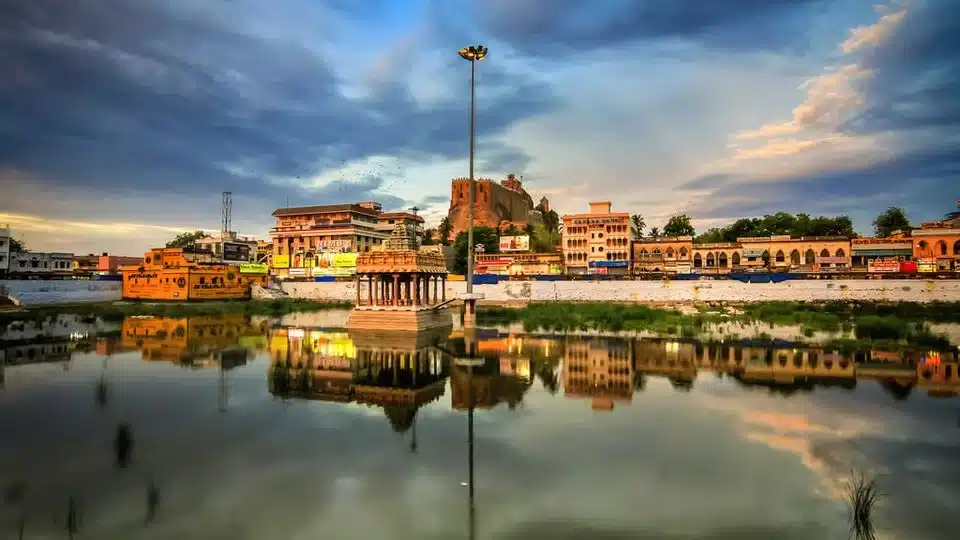Trichy (or Tiruchirapalli), one of Tamil Nadu’s oldest and most vibrant cities, is experiencing a renaissance that blends the best of its rich heritage with modern infrastructure, innovation, and urban development. Over the years, the city has remained a crucial cultural and educational hub, but now it’s evolving into a beacon of progress that reflects a new era: Trichy 2.0.
A City Steeped in History
Known for its iconic landmarks such as the Rock Fort Temple, the Sri Ranganathaswamy Temple, and the Kallanai Dam, Trichy has always been a city that cherishes its past. The historical significance of Trichy is undeniable, as it was once a major center for the Chola, Pandya, and Nayak dynasties. These deep roots in history provide a sense of identity that the modern developments do not overshadow, but rather complement.
Urban Revitalization and Infrastructure Growth
In recent years, Trichy has undergone an impressive transformation with major infrastructural upgrades. The city’s urban landscape is changing, with better roads, new flyovers, and more efficient public transport systems. The Trichy International Airport has also seen expansion, making it easier for domestic and international visitors to access the city, thus boosting tourism and business.
A new phase of infrastructure development includes the construction of IT parks, new commercial centers, and the improvement of educational institutions. The rise of co-working spaces and digital startups is encouraging young professionals and entrepreneurs to flock to the city. With a focus on sustainability and smart city initiatives, Trichy is preparing itself for future growth while still respecting its environmental needs.
The Smart City Vision
As part of India’s Smart Cities Mission, Trichy is incorporating technology into its urban planning to enhance the quality of life for its residents. Projects under this initiative include the introduction of intelligent traffic management systems, better waste management practices, and more public spaces designed for community engagement. These advancements aim to make the city cleaner, more connected, and more efficient, paving the way for the next generation of Trichy residents.
Education and Innovation Hub
Trichy has long been home to some of the state’s best educational institutions, including the National Institute of Technology (NIT) and Bharathidasan University. With a growing emphasis on research and innovation, Trichy is becoming a breeding ground for high-tech solutions and skilled talent. In recent years, the city has witnessed a surge in academic collaborations and research centers focusing on fields such as artificial intelligence, renewable energy, and biotechnology.
Trichy’s emergence as an education hub is fueling its reputation as a place where knowledge meets opportunity. As the city invests in both higher education and vocational training, it is building a skilled workforce capable of meeting the demands of the future economy.
A Cultural Renaissance
While Trichy is embracing modernity, it has not forgotten its cultural roots. The city remains a center of Tamil tradition, arts, and music. Cultural festivals like the Brahmotsavam at the Sri Ranganathaswamy Temple continue to draw large crowds, while local artists and musicians are gaining recognition both nationally and internationally. The rich blend of the old and new is evident in the city’s festivals, street art, and even in the food scene, where traditional eateries coexist with modern cafes and restaurants.
The preservation of local crafts, including handloom textiles and bronze sculptures, remains integral to the city’s identity. Trichy’s new wave of artisans is successfully melding tradition with innovation, offering contemporary twists to age-old crafts that are gaining popularity among a global audience.
A Thriving Economy
Trichy’s economy is showing promising signs of diversification. Once heavily reliant on agriculture, the city is now seeing substantial growth in manufacturing, engineering, and technology. The presence of major industries such as Bharat Heavy Electricals Limited (BHEL) has long been a cornerstone of the economy, but new developments in sectors like electronics, renewable energy, and startups are shaping the city’s economic future.
The growth of the tourism sector also plays a key role in Trichy 2.0. Visitors from across the globe are now attracted not only to its temples and historical sites but also to the city’s evolving gastronomic scene, its modern cafes, and its new-age hotels. The city’s proximity to cultural hotspots like Madurai and the vibrant city of Chennai further strengthens its position as a regional economic hub.
The Road Ahead
Trichy’s transformation into Trichy 2.0 reflects a city that is at the crossroads of history and progress. As it continues to modernize, the challenge will be to maintain a balance between growth and sustainability, between innovation and heritage. The future of Trichy lies in its ability to harness new technologies, foster innovation, and continue being a cultural touchstone while nurturing its close-knit community spirit.
In essence, Trichy 2.0 is a city that embraces the future without letting go of the past. It’s a city where tradition and modernity coexist, where technology is used to enhance lives, and where every step forward is anchored in a proud history. As Trichy continues to grow, it’s poised to become a model for other cities in India that are navigating the complexities of urbanization while holding onto what makes them unique.










